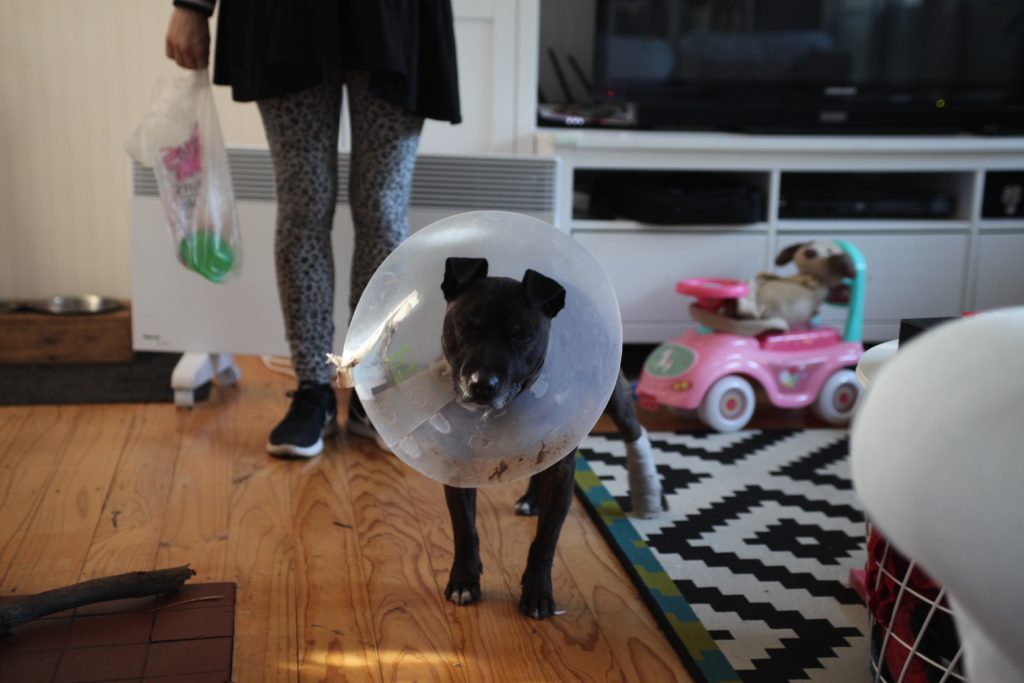A dog looks to his pet parents for a lot of things – a good diet, exercise, affection, and guidance – because he trusts his family implicitly. When he is injured, however, he might not always be as forthcoming, and owners may notice the symptoms long before the cause. Ear injuries in dogs are a prime example: when your dog is in pain or discomfort, he may just seem more tired than usual, or “off” in general, but at the first sign of blood – in, on, or around a dog’s ear – it’s time to investigate. If your dog’s ear is bleeding it’s highly advised to take precautions and get him to the vet if other symptoms are present.
 Dog’s Ear is Bleeding: Where Is It?
Dog’s Ear is Bleeding: Where Is It?
The location and amount of blood around a dog’s ear will usually indicate the severity and cause of his ear injury. In general, the further away from the immediate edge of the ear the blood is, the better the chance it’s a superficial injury, such as a cut or scab received while roughhousing or playing outside. Below, a few hypothetical scenarios to help identify the problem:
- A little blood, mostly dried; dog seems normal:
If the blood looks dark and dried and the dog doesn’t seem to be in any discomfort or pain, gently cleanse the area with a clean cloth dipped in warm water. Never spray or pour water into a dog’s ears, as this can make matters worse by introducing a canine bacterial infection or irritation.
Chances are, once some of the dried blood is cleared away, a cut or puncture on the outside edge of the dog’s ear or ear tip will most likely be the source. Keep this cut clean, and ask a veterinarian what, if anything, should be applied to the injured area.
Note: avoid “human” topical medicines unless specifically recommended by a trusted vet: dogs may ingest these during grooming and become seriously ill.
A little blood, mostly dried or patchy; dog is scratching:
Canine parasites like fleas flock to areas that are soft and delicate like a dog’s ear folds, groin, and underarms because they’re protected and able to burrow. Ear mites in dogs follow the same tactic, which means that if a pup is digging or scratching in his ears, these pests are likely to blame. Both bug bites and frequent scratching will break the skin, causing patchy or spotty blood specs around the outside and inside of the ear.
Look for evidence of fleas in the fur around a dog’s ears, such as actual adult fleas or black curly “specks”, called flea dirt. For pet parents who suspect flea dirt but aren’t sure, place the speck on a white surface and add a drop of water: flea dirt will dissolve into a dark red/brown color. Mites will produce scabbing in the ear, so if a lot of dry, flaking skin in the ear canal is noted, these pests are likely to blame.
If a dog appears to have parasites in his ears, be sure to make him a veterinary appointment right away for treatment and medicine. Ear parasite issues will almost never clear up on their own.
A lot of blood, still flowing; dog seems a little uncomfortable:
If the blood is bright red and looks to be fresh, provide the dog with an activity to calm him, such as a favorite chew treat or a little peanut butter on a plate. This will distract him and give owners a better chance to examine the ear more closely. If the dog allows it without resisting or shying away, use a warm water-dipped cloth to clear away the blood and find the source. Remember, even if it seems like a lot of blood, don’t panic. Because dog’s ears are very sensitive, they have a lot of nerve endings and blood vessels which make even the tiniest cut painful.
If the injury has caused the dog to shake his head or whimper, it may be more serious than home treatment can address, even with professional guidance. For the sake of the pet’s health, the best solution is to take him to a vet as soon as possible. If the cut is large and jagged, he may require stitches or surgical glue at the hands of a professional in order to heal properly.
A lot of blood; dog is in pain:
 For dogs that are having trouble moving, crying out, persistently circling in a confused manner, or falling over, ear bleeding could be a sign of something far more serious, such as a traumatic head injury. Keep him as immobilized as possible during the trip to the nearest emergency vet and take note of times and symptoms. Knowing when and where the bleeding and behaviors began in a sick or injured dog will help the vet diagnose and treat the problem.
For dogs that are having trouble moving, crying out, persistently circling in a confused manner, or falling over, ear bleeding could be a sign of something far more serious, such as a traumatic head injury. Keep him as immobilized as possible during the trip to the nearest emergency vet and take note of times and symptoms. Knowing when and where the bleeding and behaviors began in a sick or injured dog will help the vet diagnose and treat the problem.
Note: Letting a dog “sleep off” a serious, mobility-impairing injury with an ear bleed can be extremely harmful or even fatal. Don’t take chances – for dog owners who suspect something is wrong, head to the vet right away.
Safeguard Against Canine Ear Bleeding
Regular canine grooming, parasite treatment, and careful supervision of the family dog will prevent many of the most common ear bleeding issues. While owners should always clean blood away and investigate, unless it’s a large, jagged cut, parasites are visible, or the dog is showing signs of pain or impairment, ear bleeds aren’t a cause for concern.
Remember, humans experience small cuts frequently and rely on their body to heal itself: dogs can do the same in most cases.
Sources Cited:
- “My Dog Is Bleeding From His Ear.” Medicine Net.com (no publish date), https://www.medicinenet.com/pets/dog-health/dog_is_bleeding_from_ear.htm. Accessed April 18, 2019.
- Zeltzman, Dr. Phil, DVM, DACVS, CVJ. “What is a Dog Ear Hematoma?” Pet Health Network (no publish date), http://www.pethealthnetwork.com/dog-health/dog-diseases-conditions-a-z/what-a-dog-ear-hematoma. Accessed April 18, 2019.
- AKC Staff. “Dog Ear Infections: Symptoms, Causes, Treatment, and Prevention.” American Kennel Club (AKC.org), November 24, 2015, https://www.akc.org/expert-advice/health/dog-ear-infections/. Accessed April 18, 2019.




